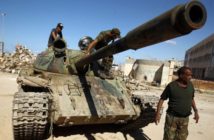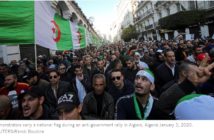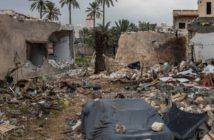By Drew Brown/CPJ Guest Blogger

Journalists ride in an army soldiers’ carrier to the front line during clashes between forces loyal to Syrian President Bashar al-Assad and opposition fighters on August 24, 2013. (Reuters/Khaled al-Hariri)
In recent years, Arab journalists have been taking great risks to report important stories in a region where war and civil unrest remain an ever-present threat. Many are operating without proper equipment or safety training in how to recognize and mitigate the various risks they face.
Those risks are apparent in CPJ’s new report on journalists killed on the job in 2013. Of the 70 journalists killed, 46 died in the Middle East and North Africa. Twenty-five of the total died in crossfire or combat, while 14 were killed on some other dangerous assignment, such as covering street protests.
This month, Arab Reporters for Investigative Journalism (ARIJ) invited me to help lead a two-day session in Amman, Jordan, on how to stay safe while covering dangerous stories. My job was to address personal security preparations, equipment and procedures for covering violent protests and combat.
I am a former U.S. Army Ranger and combat veteran. I am also a journalist who has covered the wars in Afghanistan and Iraq– both independently and embedded with U.S. and allied forces–on dozens of deployments. I have seen mobs turn from peaceful to violent in a matter of minutes, and I have been under fire on numerous occasions.
I traveled from Vietnam on behalf of Global Journalist Security based in Washington. My co-trainers were Drew Sullivan of the Balkans-based Organized Crime and Corruption Project, and Smari McCarthy, an independent, digital security expert based in Iceland.
Journalists came to the ARIJ session from all over the Arab world, and some had more experience than myself covering dangerous stories. Many had reported on the violent upheavals of the Arab Spring. A few had covered the wars in Iraq and Syria, or Israeli military strikes in the Palestinian territories and Lebanon. For most of them, the sudden outbreak of civil unrest or combat remains a hazard both on the job and at home.
To try to stay safe, I emphasized the need for proper planning, working in teams, exercising situational awareness and learning to trust one’s intuition, knowing entry and exit points, and how to witness events without getting shot. I also discussed how to react to sniper fire, the penetration capabilities of military small arms and larger weapons, and how to take cover from air strikes, artillery, and mortars.
The planning, precautions and procedures that journalists should follow while covering violent protests and combat are essentially the same. I stressed the following points, many of which are also covered in CPJ’s Journalist Security Guide, available in several languages including Arabic:
Wear body armor when the situation dictates. An anti-stab vest will protect against knives and sharp instruments. A Level IIIA vest with inserted ceramic plates and helmet will protect from shrapnel and bullets.
Take a trauma-oriented first aid course in advance, and always carry a kit that includes pressure bandages, a hemostatic agent such as QuikClot and a tourniquet to stop bleeding, and a casualty blanket to treat for hypothermia and shock.
Wear natural fibers such as cotton or wool that are far less flammable than synthetic materials, and wear drab or neutral colors that will not attract attention.
Carry prescribed anti-biotics for gastrointestinal infections, and enough personal medications, including eyewear, for the duration of the assignment.
Bring emergency rations of food and water, plus iodine, chlorine pills or carbon filters to purify drinking water if clean or bottled water is not available.
Obtain insurance in advance to cover any serious injury, loss of limb or life.
Journalists should also learn how local security forces and other armed groups operate, and they should always conduct a comprehensive risk assessment with their editors before they leave on assignment. A sample risk assessment is in the appendices of CPJ’s guide.
Journalists should never travel or work alone while covering civil unrest and war. They should always take two vehicles when traveling. They should have a plan for how they will get in and get out, and a backup plan in case the first one fails.
Journalists should maintain situational awareness at all times while covering civil unrest and war. Journalists also need to recognize when they have reached their limits, and to know when it is time to take a break from the story, or get out and go home.
I reviewed the hazards posed by tear gas and other riot control agents and rubber bullets, along with the tactics that security forces often use on protesters, and the unpredictability of mobs. I listened intensely as many of the journalists described their experiences in such situations. There was a lot of give and take, and we came to agree: there are few set rules, only guidelines.
Some of the journalists discussed the necessity of putting themselves directly in the middle of protesters or behind security forces to both get interviews and capture the action. Co-trainer Drew Sullivan and I were adamant that journalists should restrict themselves to the periphery or to an elevated position. Shaky camera footage, while sometimes dramatic, rarely lends itself to effective and compelling reporting. Journalists are better off in areas where they can effectively observe, record, and report the action. They should avoid putting themselves at risk of getting trampled, beaten, or caught in crossfire of any kind.
While several of the journalists had covered war, it was evident during the session on ballistics penetration that few had any real idea of what 5.56 mm and 7.62 mm rifle rounds–the kind used by military forces and police all over the world–can do. With the aid of briefing slides and videos, I showed how a high-powered bullet punches easily through a car door, and how even brick and concrete blocks crumble easily after just a few rounds.
The basic lesson: the earth is your friend. When shooting breaks out, hit the ground and crawl to a defilade, or protected position, inside a ditch, a depression in the ground, or the basement of a building. During air, artillery, and mortar strikes, these will provide effective cover, except in the case of a direct hit.
It is the responsibility of every news organization to ensure its reporters receive the training and equipment they need to cover dangerous stories such as civil unrest and combat. There is ample opportunity for donors and other groups to fill those needs too.
Drew Brown is a senior trainer at Global Journalist Security, and a freelance writer and photojournalist who covered the wars in Afghanistan and Iraq for Knight Ridder Newspapers from 2001 to 2003, and for Stars and Stripes from 2007 to 2010. He served as an airborne infantryman with the U.S. Army’s 75th Ranger Regiment from 1989 to 1993, and is a combat veteran of Operation Just Cause, the 1989 U.S. invasion of Panama.






